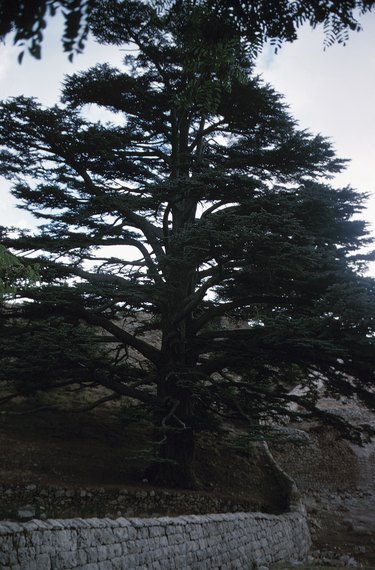
Cedars are evergreen trees and shrubs from several different genera and species. Their hardiness varies depending on species, but fragrant needles and pest resistance make cedar trees and shrubs a common landscape feature. However, cedars are susceptible to a disease that causes yellowing or browning of the branches from the top down as cankers cut off nutrients to the tips of the branches.
Cedars and Seiridium Canker
Video of the Day
Cedar species are part of the cypress plant family (Cupressaceae), which also includes junipers and cypress trees. Plants in this family share similar physical traits as well as vulnerability to some of the same diseases. Canker infections such as seiridium canker disease is common among cypress family plants, and infection can kill individual trees or entire mass plantings if it becomes severe enough.
Video of the Day
Causal Fungi
Seiridium canker disease attacks cypress family plants across the United States, but is caused by three fungal species, each of which tends to be more common in specific regions of the country. Seiridium cankers caused by the fungus Seiridium cardinale, which is typically the most damaging of the three fungi, are usually found in California cedars, while infections caused by Seiridium cuppressi fungus are typically found in Florida-grown cedars. Canker infections caused by the fungus Seiridium unicorne are primarily a problem in the south central and southeastern states. All three fungal infections cause the same type of damage to cedar species and produce black asexual fruiting bodies that resemble small blisters. These blisters break through the bark during wet weather. Seiridium cardinale fungus also produces fruiting bodies in cone scales.
Symptoms from the Top Down
Seiridium cankers are typically reddish, sunken, oval lesions with resin oozing from the margins. An early symptom of seiridium canker disease is tip dieback on individual branches, which fade from green to yellow to reddish-brown because of the cankers girdling the branches and denying nutrients to the extremities. The main trunk, referred to as the central leader, begins to turn brown from the top down as it dies. Mature cedars may take several years to die, but seiridium canker disease may kill young cedars in less than a year.
Managing the Disease
There is no effective chemical treatment for cedars infected with seiridium canker disease. However, you can prune out infected branches, cutting 1 inch below the canker wounds. After each cut, sanitize your pruning tools by soaking them in one part chlorine bleach to nine parts water to prevent spreading infection to healthy portions of the tree. While pruning out the infected branches may prolong your cedar's life, it may not stop the infection. Remove cedars with severe symptoms, such as extensive dieback, to prevent the spread of infection to healthy trees. Trees that aren't stressed by drought, pests or nutrient deficiencies are typically less prone to infection.
- University of Florida Extension: Seiridium Canker of Leyland Cypress
- Oklahoma State University Extension: Seiridium Canker of Junipers and Cypress
- Arizona State University Cooperative Extension: Seiridium Canker of Cypress Trees in Arizona
- U.S. Department of Agriculture: Classification for Kingdom Plantae Down to Family Cupressaceae